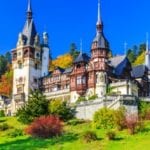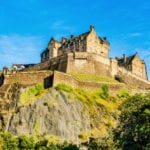 Mysteries
Mysteries  Mysteries
Mysteries  History
History 10 Surprising Stories About the Texas Rangers
 Humans
Humans 10 Philosophers Who Were Driven Mad by Their Own Theories
 Miscellaneous
Miscellaneous 10 Video-Game-Worthy Weapons and Armors from History
 Weird Stuff
Weird Stuff 10 Psychics Who Accurately Predicted Wartime Events
 The Arts
The Arts 10 Pieces of Art Inspired by a Broken Heart
 Health
Health 10 Science Fiction-Sounding New Medical Treatments
 History
History 10 Surprising Facts About the Father of Submarine Warfare
 Space
Space Ten Astonishing New Insights into Alien Worlds
 Weird Stuff
Weird Stuff 10 Bizarre Summer Solstice Rituals Still Practiced Today
 Mysteries
Mysteries Top 10 Haunting Facts About the Ghost Ship MV Alta
 History
History 10 Surprising Stories About the Texas Rangers
 Humans
Humans 10 Philosophers Who Were Driven Mad by Their Own Theories
Who's Behind Listverse?

Jamie Frater
Head Editor
Jamie founded Listverse due to an insatiable desire to share fascinating, obscure, and bizarre facts. He has been a guest speaker on numerous national radio and television stations and is a five time published author.
More About Us Miscellaneous
Miscellaneous 10 Video-Game-Worthy Weapons and Armors from History
 Weird Stuff
Weird Stuff 10 Psychics Who Accurately Predicted Wartime Events
 The Arts
The Arts 10 Pieces of Art Inspired by a Broken Heart
 Health
Health 10 Science Fiction-Sounding New Medical Treatments
 History
History 10 Surprising Facts About the Father of Submarine Warfare
 Space
Space Ten Astonishing New Insights into Alien Worlds
 Weird Stuff
Weird Stuff 10 Bizarre Summer Solstice Rituals Still Practiced Today
10 Castles Still Owned By Nobility
The vast majority of castles these days are little more than ruins preserved by charitable organizations for educational value. In the past, these castles belonged to either nobility or royalty, but over time, whether through war, debt, or donation, they have passed out of their ownership. This pattern of loss accelerated from 1700 onward, as agricultural estates became less profitable over the course of the Industrial Revolution, leading to the long-term loss of wealth by the landowning class.
Despite this, some noble families still own castles today—and a few, like the Percy family of Alnwick Castle, have owned their castle for hundreds of years. Most of these families have replaced their agricultural incomes with money made by opening their properties up to public access. This means that many of these castles are still visitable today, allowing us the privilege of seeing a castle in full occupation with our own eyes. Today, we’re exploring ten castles that are still owned by the nobility.
10 Alnwick Castle
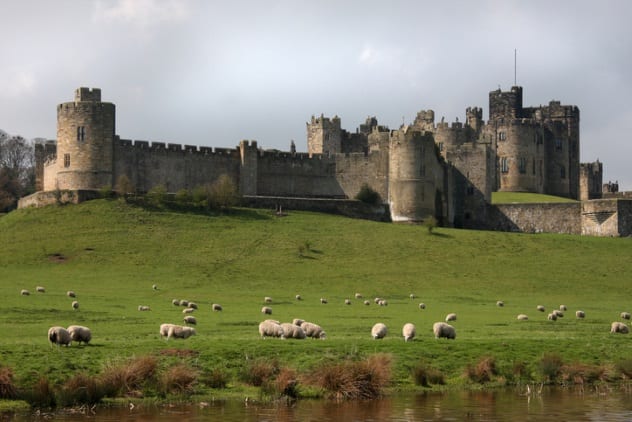
In its early history, Alnwick Castle was a border fort designed to protect Northern England from Scottish raiders.[1] It was little more than a military outpost and had little importance. King John ordered it demolished in 1212, but fortunately, his orders were not carried out. The Percy family purchased it in 1309 and began a series of ambitious building projects, setting it up as the seat of their lands and a comfortable home as well as a formidable fortress. It has been their ancestral home ever since, through numerous generations of Percys—including the infamous Harry Hotspur, who led a major revolt against the English monarchy.
It is one of the most beautiful and well-preserved castles in England today, and parts of it were used for the interior of Hogwarts in the Harry Potter films. It is the second-largest occupied castle in England, after the Queen’s own residence of Windsor Castle. The Percy family has also been very meticulous in keeping its old records safe, and the family archive, which dates back to the 1300s, is an important historical source which is used frequently by historians even today.
In modern times, the Duke and his family still live in the castle but only use a section of it. Other parts are used as accommodation by the Estates Office and students of St. Cloud State University as part of their international study program. The rest of the castle is open to the public.
9 Dunnottar Castle
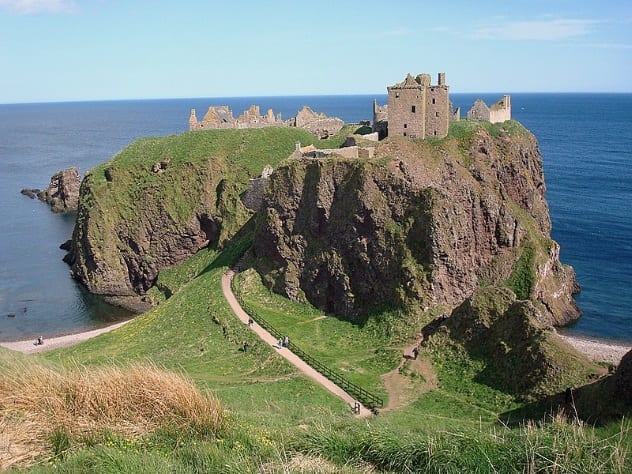
Dunnottar is one of the most important castles in Scottish history. Its fantastic strategic position on a rocky headland makes it almost impervious to enemy attack.[2] Because of this, it was chosen as the place to hide the crown jewels of Scotland, the Honours of Scotland, from Oliver Cromwell’s rampaging army during the brief time of the English Commonwealth. It was held by Clan Keith for hundreds of years, and they became the hereditary Earls Marischal, making it their job to protect the king with their lives. Their fortunes ended, however, in 1715, after George Keith joined the Jacobite rebellion. His lands were declared forfeit, and the castle was seized by the crown. It was then sold to the York Buildings Company, which dismantled much of the building.
The Keith family regained Dunnottar but sold it again in 1925 to the Viscount of Cowdray, whose family own it to this day. By the time the Cowdrays bought it, the castle was in a state of ruin, and they embarked on a mission of restoration. It has remained open to the public since and attracts tens of thousands of visitors a year. The Cowdrays own multiple estates, so they don’t actually live at the site.
8 Eilean Donan Castle
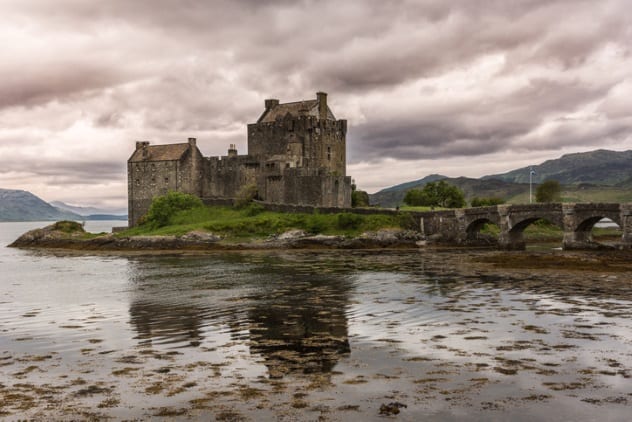
Lying on an isolated eponymous island in a strategic position on Scotland’s western coast, Eilean Donan Castle is one of the most recognized images of Scotland today.[3] It is one of the most photographed buildings in Scotland and is the third-most-visited Scottish castle, receiving over 300,000 visitors a year. Because of its location, it was also the site of dozens of clan feuds over the centuries but was frequently owned by Clan Mackenzie and their allies Clan Macrae, who ran the castle in their name. Clan Macrae defended Eilean Donan Castle numerous times in the Mackenzies’ names, but the centuries-old alliance broke down when the Mackenzies joined the Jacobite rebellion.
During the rebellion, the Spanish, who were supporting the rebels, were allowed to occupy the island. The British navy retaliated with an intense naval bombardment, destroying much of the castle. After they took the Spanish survivors prisoner, they continued to blow up much of the remaining ruins with 27 barrels of gunpowder.
The castle lay in ruins for exactly 200 years before a descendant of Clan Macrae, John Macrae-Gilstrap, bought it in 1919. He set about restoring it and opened it to the public in 1955. It has remained under the protection of the Macrae family ever since, though the family doesn’t live at the site. They established the Conchra Charitable Trust in 1983 to manage and maintain the castle.
7 Arundel Castle
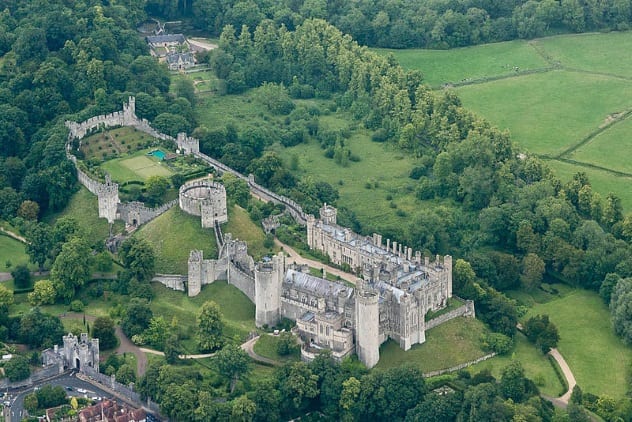
Arundel Castle is one of the oldest castles in England, first built in December 1067—barely a year after the Norman conquest.[4] It is also remarkable for being passed down through generations almost directly for nearly 1,000 years. It was owned for long periods by the Aubigny family from 1139 to 1243, occasionally reverting back to the crown. In 1243, it passed to the FitzAlans after the final Aubigny heir, a woman, married into the family. The FitzAlans held it until 1580, when Mary FitzAlan married Thomas Howard. The Howards have held the castle ever since, but it didn’t become their main residence until the 1780s.
Arundel has been continually upgraded since it was first built in 1067, so much of the castle we see today is much more modern than that. The majority of the building—including the Gothic front which gives it its fairytale appearance—was built during the Victorian era. It was one of the first buildings in England to be fitted with electricity, central heating, and service lifts. Much like Alnwick castle, Arundel has an extensive archive featuring documents going back to the 1200s, though it is only open to professional academics.
6 Bamburgh Castle
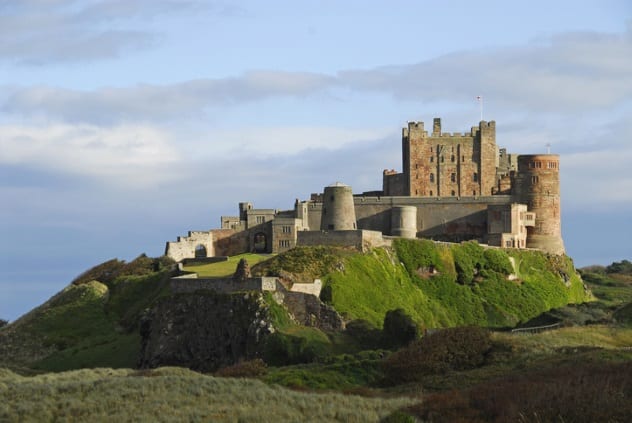
Bamburgh Castle is one of the most famous and picturesque castles in the UK. It was first the site of a formidable Anglo-Saxon fortress, which the historian Bede described as one of the most important places in Britain. It was a source of strength for the Northumbrian kings for many years before the Norman conquest. Following an attempted rebellion, the castle was taken by the crown in 1093. The crown then held it for 500 years before selling it to the Forster family, who had been governors of the castle for generations, in 1600.[5]
It wasn’t long, however, before the Forsters went bankrupt, and the castle was sold to the Bishop of Durham, who had it converted into a hospital. It was finally sold to William Armstrong, First Baron Armstrong, in 1894, whose family still owns it to this day. It is one of the very few castles in the UK owned by a family whose first owner wasn’t a noble when they were born. (Armstrong was knighted for his many scientific achievements.) The Armstrongs opened the castle up to the public in the early 1900s.
Today, the castle remains an icon of Northeast England, appearing in dozens of films and books. It has also been a center of archaeological importance ever since several key Anglo-Saxon discoveries on the site in the 1960s.
5 Dunrobin Castle
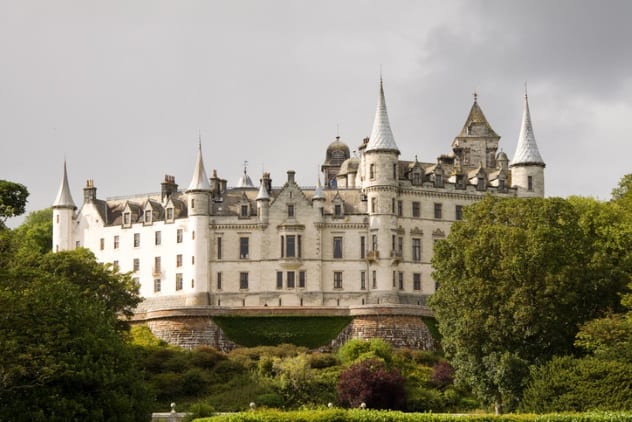
Dunrobin Castle is one of the most interesting castles in the British Isles: It is the most northerly of Britain’s inhabited castles and one of the largest, with 189 rooms.[6] Despite this, it has a distinctly continental appearance, having been remodeled in the French chateau style during the Victorian era. It wouldn’t be out of place in the rolling hills of Southern France.
Despite its sophisticated modern appearance, it has a barbaric history. It was built to control a savage, barbaric region of Northern Scotland which frequently changed hands between the Vikings and Scots. The Gordon family, who control it to this day, first held the castle in 1512, when Adam Gordon married the daughter of the lord. The Gordons then successfully brought a writ of idiocy against the lord’s son, and when the lord died, the estate fell into their possession. The castle was taken from them by Alexander Sutherland, the legitimate heir, in 1518, but when the Gordons returned, they killed the usurper and placed his head on a spike on top of the castle tower. Alexander’s son tried to take the castle in 1550 but was killed in the castle garden. The Gordons changed their surname to Sutherland shortly after to enhance their legitimacy.
In the years that followed, the Sutherlands added to the castle, making it more comfortable and defensible. It became their family seat, a position it held until 1963, when the castle and the dukedom split: The old lord’s male heir inherited the Duchy of Sutherland, but his daughter, the present Countess Elizabeth, inherited the castle.
4 Berkeley Castle
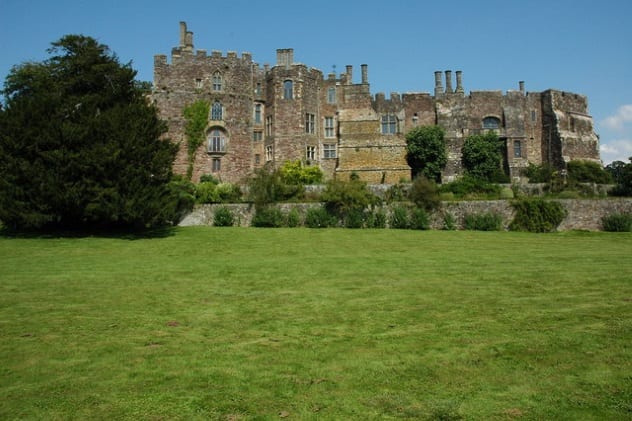
Berkeley Castle in Gloucestershire is the home of one of only two noble families in England who can trace their lineage back to Anglo-Saxon lords from before the Norman invasion.[7] The Berkeley family, originally the Fitzhardings, were granted the castle in the 1100s and have held it ever since. It is the oldest castle in England to be continuously owned and used by the same family and contains a bed which has been identified as the oldest piece of furniture used by a single family.
Unlike many of the castles on this list, Berkeley Castle’s architecture has remained largely unaltered since the 1400s. It was the site of several historical events: It is believed to be the site where King Edward II was murdered, and it was the place where the last court jester in England, Dickie Pearce, died when he fell from the minstrels’ gallery. In the English Civil War, the castle was besieged by parliamentary forces who breached the walls with a cannon. The Berkeleys were allowed to remain in the castle as long as they didn’t repair the breach, a rule enshrined in law by Parliament: The breach is still there today.
3 Haddon Hall
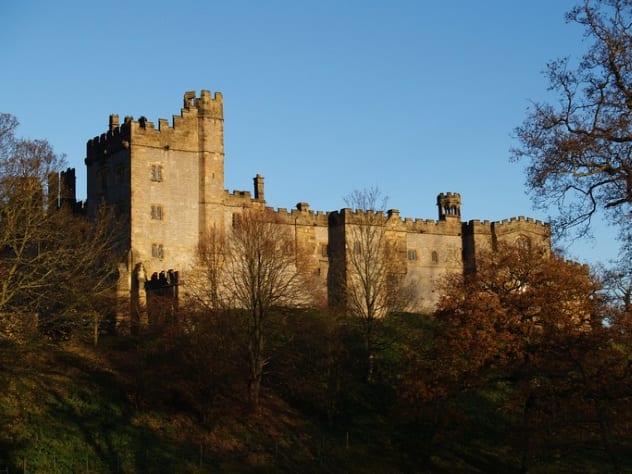
From the very start, Haddon Hall was intended to be a family home rather than a castle. Successive chaos over the course of the 1100s, however, led to the family building a defensive wall around it in 1194. It now straddles the line between castle and manor house, featuring aspects of both in equal measure.[8]
The castle was originally owned by the wealthy, venerable Vernon family. In the 1560s, however, Sir George Vernon’s daughter, Dorothy, fell in love with a lower noble, John Manners. George despised the arrangement, considering John and his family of lowly status and shaky financial stability. He forbade them from seeing each other. Dorothy and John made a plan, and during a bustling ball, Dorothy snuck out of the hall and met John on horseback at the bridge, where they rode off to be married. George Vernon died two years later, and the Manners family inherited the estate, which they own to this day.
The Vernons had spent much of their wealth expanding the original hall, but the Mannerses, who chose another place as their main residence, allowed it to fall into disuse. In the 1920s, John’s descendant, also named John Manners, recognized the hall’s importance and began restoring it to its original glory. It is now considered one of the best-preserved examples of a medieval manor house. It is now the home of Lord Edward Manners, but the hall is open to the public for much of the year.
2 Inveraray Castle
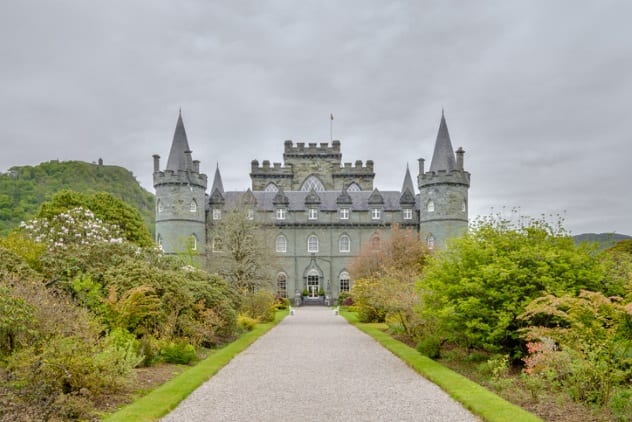
By far the newest of the castles on this list, Inverary’s foundation stone was placed in 1746, though a castle has existed on the site since the 1500s.[9] It sits on the shore of Scotland’s longest sea loch, Loch Fyne, and it was one of the first buildings in the Gothic Revival movement, which became one of the most influential and popular architectural styles in history. The castle is famous for its dark, foreboding appearance. This appearance has been purposely cultivated: In the 1770s, the actual village of Inveraray was moved to enhance the castle’s isolated appearance.
It is the seat of the Dukes of Argyll, the chiefs of Clan Campbell, one of the biggest (and most historically controversial) Scottish clans. In contrast to many other noble families, who typically only live in a very small section of their castles, the Campbells occupy two whole floors of the castle and two of its four corner towers. Nevertheless, a large portion of the castle is open to the public today, including the armory hall, which contains a collection of hundreds of weapons in a room with a ceiling that, at 21 meters (69 ft), is the highest ceiling in Scotland.
1 Belvoir Castle

Belvoir was another one of the first wave of English castles built in 1067. Originally established as a manor house, it was granted to Robert de Ros in 1257, who obtained permission to turn it into a castle a decade later.[10] However, the castle had fallen into ruin by the time the Manners family inherited it in 1508. The Mannerses, who still live there today, had a new castle built on the site.
This was only the first of many times the castle was destroyed and rebuilt: It was torn down by the Parliamentarians in 1649 and rebuilt in 1668, rebuilt again in 1799, and destroyed by a fire in 1816 before being reconstructed for the final time in 1832. The castle today retains a traditional medieval appearance despite being relatively new and is one of the most well-known examples of Regency architecture in the world. It features regularly in movies, including as a stand-in for Windsor Castle and as Castel Gandolfo in The Da Vinci Code.
Read about more amazing castles on 10 Amazing Castles In Europe You’ve Probably Never Heard Of and 10 Unique Ruined Forts and Castles.
